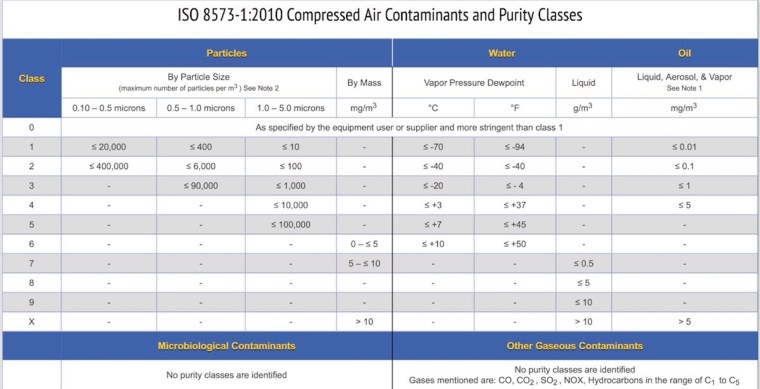Airborne particles surround us everywhere. In a general work environment, nearly four million particles per cubic foot is floating around us at any given time. When a compressor compresses this air, the concentration increases substantially. So, compressed air is not only expensive to make, but very dirty. As the air exits your air compressor and travels into your pneumatic system, there is so much contamination that the International Standard Organization, ISO, created an Air Quality chart with Purity Classes.

This chart is easy to follow and can be found in the ISO8573-1 standard for Air Quality. It is used to select a cleanliness level for your compressed air system. The contamination is categorized into three areas; Particles, Water, and Oil (reference above). A Class is associated with a number for each category ranging from 0 (most stringent) to 9 (most relaxed). As an example, an Air Quality value of ISO8573-1:2010 [1.2.4] has a Class 1 for Particles, Class 2 for Water, and Class 4 for Oil. These Class values will show the maximum value in each category.
To define the categories in more detail, I will separate the three to discuss the origins and solutions.
- Particles: For solid particles, this part comes from many different areas. The surrounding ambient air that is being drawn into the air compressor is filtered; but the intake filter will only remove large diameter particles. The smaller diameter particles will go through the filter and into the compressed air system. Another part is rust particles that occur from steel air pipes and receiver tanks. Over time, rust will flake off and create particles that can affect pneumatic equipment. Other particles can come from components inside the air compressor, valves, etc., that wear and breakdown. In the ISO column for Particles, it is separated into three different micron ranges and concentrations. The removal of particles from the compressed air is done by traps and compressed air filters. EXAIR offers two types; Filter Separators with 5-micron filtration and Oil Removal Filters with 0.03-micron filtration. There are other types of filtration systems depending on your ISO requirement.
- Water: Humidity is a natural occurrence as water vapor in the surrounding air. It can be measured as a dew point temperature. This is the temperature at which water will condense and make rain. Inside an air compressor, the air is ‘squeezed”, and the amount of space for water vapor is reduced. So, it will condense into liquid form as “rain” inside the pipes. Air that comes out from an air compressor will always be saturated with water. To remove liquid water, a mechanical device can be used. Inside a Filter Separator, a centrifugal separator will spin the air and remove the liquid water. To remove water vapor, a compressed air dryer is required like a refrigerant, desiccant, deliquescent, or membrane type. Each type will have a dew point range that they can reach. As an example, a refrigerant type will reduce the dew point near 37 oF (3 oC). That means that water will not condense until the temperature reaches below 37 oF (3 oC).
- Oil: This category can be found as a liquid, aerosol or vapor, and it includes more than just oil. It contains small hydrocarbons, CO, CO2, SO2, and NOX. Oil mainly comes from inside an oil-flooded air compressor. As the air passes through the compressor, it will pick up remnants of oil aerosols and carry it downstream. With high temperatures inside the air compressor, some of the oil will vaporize. Even with oil-less type air compressors, carbon vapor can still be an issue. Small hydrocarbons can come through the air intake and condense inside the system like water vapor above. To remove the liquid and aerosol type of oil, Oil Removal Filters can be used. They are designed to “coalesce” the small particles into larger particles for gravity to remove. Oil vapor requires an activated carbon to remove. These types of filter units will adsorb the vapor. This helps to remove odors as well as dangerous chemical vapors that may be in the compressed air line.
There are a variety of pneumatic systems that use the ISO8573-1 standard. This will include breathing air operations, food and beverage, pharmaceutical, and the electronic industries. If you need stringent requirement for your compressed air system, the Air Quality standard should be used by referring to the Class numbers above. This helps to dictate the types of filtration and air dryers that should be used within your pneumatic system. If you have any questions about your compressed air system, an Application Engineer at EXAIR can help.
John Ball
Application Engineer
Email: johnball@exair.com
Twitter: @EXAIR_jb
ISO 8573-1 Chart by Compressed Air Best Practice.